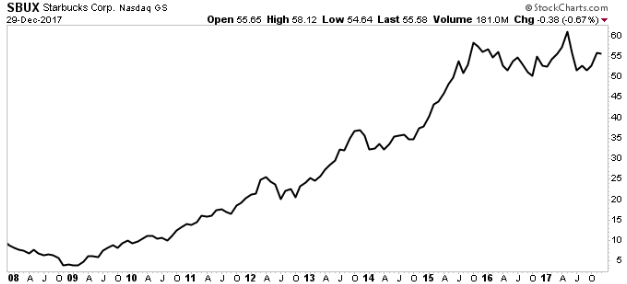Possibly the Most Valuable Stock Market Essay You’ll Ever Read

Do This Before Investing Any Money in the Stock Market
If you want to make more money in the stock market, then this might be one of the most important essays you’ll ever read. That’s because today I will reveal the most powerful investing secret I have ever learned in my financial career.
You need to pay careful attention to every word in this article. The information I am about to give you has already made a few people very rich. It can do the same for you.
More importantly, this lesson can also help you sidestep money-losing stocks. If I had understood this concept earlier, it could have saved me tens of thousands of dollars in investment losses. Keep an open mind until you’ve finished reading this entire article and your financial reward could be humongous.
But first, let me tell you a story.
Most athletes get by on talents blessed upon them by superior genetics. Sometimes, however, a player can squeak through by outsmarting their opponents. In my case, the latter most definitely applied.
I played defense during my junior hockey career. Try picturing long bus rides through rural towns in the northeast and playing in arenas that could seat no more than 200 people. I had little in the way of size, speed, or stamina. But what I lacked in raw skill I more than made up for in what coaches called “hockey IQ.”
Thanks to a deep understanding of the game, I always knew where to be at all times. I ate up minutes on the penalty kill like a rabbit goes through carrots. And in a one-on-one situation with an opposing forward coming down the ice, they could almost never beat me.
My secret? I lived by the hockey cliché to “watch the man, not the puck.” An attacking forward can do a lot of things to mislead a defenseman. Quick hand movements can make you think he’s turning left. A fast head bob can force you to turn right. But there’s one thing he can’t mislead you with: his chest. Whatever direction the forward moves his chest, that is where he’s going to skate. By watching the crest of his uniform, you can predict exactly where he’s going to go next.
The same thing applies in the business world.
Every management team says they’re looking out for their shareholders’ interests. They pepper us with phrases like “value creation” and “investment returns.” Every investor presentation features some combination of metrics that proves beyond a shadow of a doubt that this company’s management team has done an exceptional job of managing their shareholders’ capital.
Yet despite the glowing reports, the numbers don’t lie. Some stocks underperform year after year because executives see the company as their personal piggy bank. Never mind that we as shareholders front all the money to actually fund the business. And if things don’t work out, we will be the ones left holding the bag.
Here’s a question that drives you nuts (or at least it should if you spend any time in the world of business): how do we as investors determine whether a company’s management team really works in the best interests of their shareholders?
Like a defenseman trying to predict whether a forward will go left or right, we need some kind of indicator of a CEO’s true intentions. Because, with such a tool in hand, we could discard bad investments at a glance. And by extension, we could spot the next crop of stock market winners.
My solution? If hockey players should “watch the man, not the puck,” then investors need to “watch the money, not the talk.”
Silly rhyme scheme aside, the phrase makes a serious point. Management teams will say just about anything to get your investment dollars (or at least anything they can get past the lawyers in tight underwear). And for that reason, I never listen to their comments. But there’s one thing they can’t mislead you with: the money.
Five telltale indicators will show you, much like a forward’s chest, exactly how an executive will manage your capital. And by extension, once again, this will tell you almost exactly how your investment will perform.
So let’s get to it.
Dividends
If I had to pick one single indicator to show whether executives cared about their shareholders, it would be dividends.
Distributions indicate management’s willingness to reward investors rather than just line their own pockets. And once a company starts paying dividends, shareholders usually expect those payments to keep rolling in. That forces those in the c-suite to think far into the future—years, if not decades.
But dividends have another big advantage: they ration capital. Executives, for the most part, have an incentive to grow the business as large as they can. Guiding a bigger company, after all, often comes with a bigger paycheck. Managers also get a thrill when they grace the covers of popular business magazines.
But inflated executive egos won’t fund your retirement. Growth, either through flashy acquisitions or expansion projects, often fail to generate sufficient returns for shareholders. For this reason, investors often do better when companies simply mail them a check. It’s usually more lucrative to milk the returns of a smaller, exceptionally profitable business.
Analysis by Ned Davis Research backs up this point. If you had invested $100.00 into a portfolio of dividend growth stocks in 1972, your portfolio would be worth $7,499 today. By comparison, the same investment in the equal-weighted S&P 500 index would have grown to only $2,741.
A $100.00 investment in a portfolio of non-dividend-paying stocks (in other words, the type of companies likely not working in the interests of their shareholders) would have grown to only $305.00. (Source: “The Power of Dividends – Past, Present, and Future,” Hartford Funds, last accessed July 10, 2019.)
Returns of S&P 500 Stocks by Dividend Policy
| Growth of $100 Between January 1972 & December 2018 | |
| Dividend Growers & Initiators |
$7,499 |
| Dividend Payers |
$5,227 |
| Equal-Weighted S&P 500 Index |
$2,741 |
| Dividend Non-Payers |
$305.00 |
| Dividend Cutters and Eliminators |
$69.00 |
(Source: Ibid.)
Buybacks
While I love dividends (they’re the focus of this web site, after all), they don’t capture all the ways companies return money to shareholders. In recent decades, savvy management teams have supplemented distributions with stock buybacks.
Think of a business like a pizza divided up into slices. Buybacks reduce the number of slices, leaving a bigger piece for the remaining shareholders. Every time executives buy back shares, it increases our claim to a company’s future earnings.
The end result, however, is similar to dividends: buybacks reduce the amount of capital that managers can invest in ego-boosting side projects and expensive acquisitions. In other words, they’re proof positive that executives are working in the best interests of their shareholders.
Billionaire Warren Buffett has long advocated for share repurchases. I mean, take a look at the top positions of his holding company, Berkshire Hathaway Inc. (NYSE:BRK.A, BRK.B): Apple Inc. (NASDAQ:AAPL), Bank of America Corp (NYSE:BAC), Wells Fargo & Co (NYSE:WFC), The Coca-Cola Co (NYSE:KO), and American Express Company (NYSE:AXP). (Source: “Hedge Fund – Berkshire Hathaway,” Insider Monkey, last accessed July 10, 2019.)
“All managements say they’re acting in the shareholders’ interests,” Buffett once quipped. (Source: “Beating the market by buying back stock,” Fortune, November 21, 2012.)
“What you’d like to do as an investor is hook them up to a machine and run a polygraph to see whether it’s true. Short of a polygraph, the best sign of a shareholder-oriented management—assuming its stock is undervalued—is repurchases. A polygraph proxy, that’s what it is.”
A study by Catalyst Capital Advisors backs up this point. They found that a portfolio of companies that spent the most money as a percentage of their market capitalization outperformed the S&P 500 in 11 out of 14 years during the study period. More importantly, the buyback portfolio generated a total return of 492.7%, versus 66.2% from the broader market. (Source: “Exploiting Excess Returns From Share Buyback Announcements,” Catalyst Capital Advisors, last accessed July 10, 2019.)
Insider Ownership
I like executives who put their money where their mouth is.
Even if they oversee large, publicly traded businesses, managers with a large stake in the company often run operations like a family business—paying close attention to expenses and long-term strategy.
These executives don’t usually worry if quarterly results fall a penny or two short of analysts’ expectations. They’re more focused on the long-term health of the company—because their own retirements depend on the success of the business, too.
Additionally, companies with a large amount of insider ownership also tend to offer more generous dividends because that’s how executives get paid.
Think about it: if a manager received a $1.0-million salary, most of it would get taxed at the top marginal tax rate of 40%. That same check paid in dividends, however, would be taxed at almost half that rate. So executives, looking to shelter a little money from “Uncle Sam,” effectively align their interests with shareholders.
It should come as no surprise, therefore, that businesses with a high degree of insider ownership tend to outperform their counterparts. According to a study by Bain & Co., these stocks generate 3.1 times better investment returns than all other companies. Additionally, firms with higher degrees of insider ownership achieve longer and more profitable growth. (Source: “Founder-Led Companies Outperform the Rest — Here’s Why, Harvard Business Review, March 24, 2016.)
Pay Package
Much media attention has been focused on excessive management pay. CEO compensation, many argue, has grown far beyond any bound of reason. And with executives pocketing more and more money, companies have less cash left over to reward shareholders.
I disagree. The basic problem with existing compensation isn’t how much companies pay CEOs. Instead, investors need to focus on how firms decide to pay their managers.
Compensation policy represents the most important factor to an organization’s success. It determines how top executives will behave. It also determines the type of executives a firm will attract. For this reason, companies that design pay packages that reward superior performance (and impose meaningful penalties for poor results) will likely generate better results over the long run.
A good grasp of incentives can instantly make you savvier in all of your business dealings. Because at the end of the day, people will do exactly what they get paid to do. If your financial advisor receives a big commission to hawk high-fee mutual funds, don’t be shocked when they recommend those products at your next appointment. If your broker gets paid on each trade, they will likely always have a “great” new investment opportunity to pitch.
Last year, Tesla, Inc (NASDAQ:TSLA) offered CEO Elon Musk a new pay package promising him billions of dollars in stock options if the company’s market capitalization grows to at least $100.0 billion. (Source: “Elon Musk made more in 2018 than the next 65 highest-paid CEOs combined, according to a report,” Business Insider, May 25, 2019.)
I have no opinion on the future of the stock or electric cars in general. The problem here, however, is that Musk now has a big incentive to dilute investors as a method of growing the company, even if new projects offer poor returns. That quite possibly could lead to disappointing results over time.
So what exactly should investors look for in a good CEO’s pay package? Best practices in management compensation generally consist of three things. First, a pay package should require CEOs to become substantial owners of the company’s stock. Second, salaries, bonuses, and stock options should be structured to reward superior performance and penalize poor returns. Third, there should be a real threat of dismissal in the event that a company underperforms.
The One-Dollar Premise
Investors can use a simple tool to judge not only the attractiveness of a business but also how well executives have managed shareholder capital: the “one-dollar test.”
The idea here is, if an executive team does a good job, each dollar of retained earnings—the profits a company makes that don’t get paid out to investors—should translate into at least one dollar of market value. Through this method, we can spot outstanding executives at a glance.
For example, I’ve often described former Starbucks Corporation (NASDAQ:SBUX) CEO Howard Schultz as the Wayne Gretzky of corporate managers. And you only need to look at the company’s financial statements to see why. From 2008 to 2017, Starbucks generated $23.1 billion in net income. From these profits, the coffee giant retained $17.9 billion to fund its expansion.
How well did Schultz do? In 2008, Starbucks’ total market capitalization stood at $10.9 billion. Over the next decade, the company’s valuation grew to $78.7 billion. So, for every dollar Starbucks retained, management created $3.80 in market value. In other words, management’s performance was lights out.

Chart courtesy of StockCharts.com
In short, investors need to ignore what managers say and watch what they do.
The five points I outlined above are an acid test for executive teams. Management doesn’t need to meet every single criterion. But if a company passes three or four of these tests, then you likely have a real winner on your hands.











